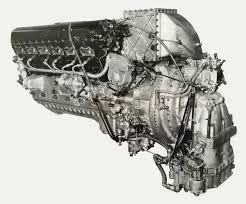Rolls Royce Merlin
 Click on image for larger version
Click on image for larger version
In the early 1930s Rolls Royce were planning their future engine development and decided on two main designs of liquid cooled engines.
The 700hp Peregrine was to be a supercharged development of the existing Kestrel, and by combining two Peregrines on a common crankshaft into an X configuration of twenty four cylinders created the !,700hp Vulture engine to be used on the lamented twin engined Avro Manchester bomber that was later developed into the four engined Avro Lancaster aircraft.
Between these two extremes there was need for a twelve cylinder engine designed using the technology of the Kestrel production that could be fitted to single engined aircraft. This resulted in the development of a new 1,100hp class designated PV-12 (Private Venture - 12 cylinders). The new engine first ran on October 15, 1933, and first flew in April 1935 powering a Hawker Hart biplane aircraft.
The British Air Ministry provided funding for the further development of the engine, now named Merlin, the C, 900hp variant of which powered the first flight of the prototype Hawker Hurricane on November 6, 1935.
Thirty three odd prototypes ending with the Merlin F rated at 1,035hp were ready for production, after which the variants were designated numerically. The first production variant became the Merlin 1 that powered the Mk1 Hurricane, Spitfire, Bolton Paul Defiant and Fairey Battle. The Merlin 11 and 111 introduced in 1938 powered practically all other new RAF aircraft of the period and 9,700+ of these engines were produced.
Development of over fifty variants continued throughout the WW2 years. Higher octane numbers and supercharger development resulted in power output increasing from 1,035hp through 1,500hp until the last variant installed in the de Havilland Hornet produced 2,030hp.
Merlin production ceased in 1950 with almost 150,000 engines delivered, 100,000 odd were built by Rolls Royce and 50,000 odd were built under license in the USA by Packard and designated Packard (Rolls Royce) Merlin 1650, and powered the North American P51aircraft.
|
TECHNICAL DATA- Merlin 61
Cylinders Length Width Height Bore and Stroke Displacement Dry weight Valve system Supercharger Fuel system Oil system Cooling system Reduction gear Power output Specific power Compression ratio Power to weight ratio Fuel consumtion |
V 12 cylinder supercharged liquid cooled piston engine 88.7in (2,253mm) 30.8in (782mm) 40.0in (1,016mm) Bore 5.4in (137mm) and Stroke 6.0in (152mm) 1,649 cu in (27.0L) 1,640lbs (744kg) Overhead cam shaft, 2 intake and 2 exhaust valves per cylinder 2 speed, 2 stage with automatic boost control Twin choke up draught Rolls Royce carburettor Dry sump, 1 pressure and 2 scavenge pumps 70% water, 30% Glycol mixture pressurised 0.42/1 1,280hp @ take off 1,565hp @ 12,250feet (3,740m) M supercharger gear 1,580hp @ 23,500feet (7,200m) F supercharger gear 0.96hp/cu in 6/1 0.96hp/lb 130 gallons per hour maximum 30 gallons per hour minimum |
